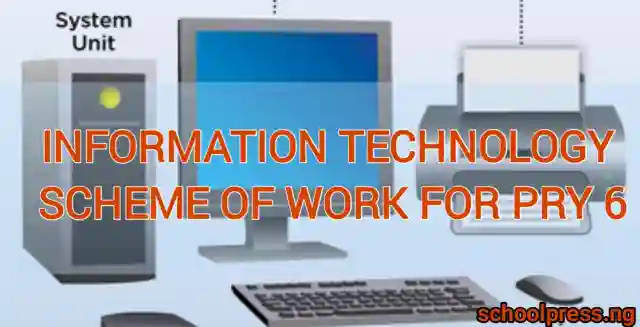Basic Technology Scheme of Work for Primary 6 is a comprehensive program designed to provide students with a practical understanding of various technological concepts. The scheme covers three terms, each with unique topics and content aimed at enhancing the student’s knowledge and skills in basic technology. In this article, we will delve into the scheme of work for Primary 6, highlighting the key topics and content covered in each term.
The first term of the Basic Technology Scheme of Work for Primary 6 focuses on light, color, and drawing instruments. Students are introduced to the various components of light, including the colors in white light and the dispersion of light. They also learn about types of colors, natural colors of objects, and the practical extraction of colors. Furthermore, the term includes lessons on the uses of drawing instruments and care of drawing instruments, providing a solid foundation for understanding basic technological principles.
Moving on to the second term, students are introduced to woodwork and its hand tools. They learn about measuring tools, marking tools, cutting tools, and the uses of these tools. Additionally, the term covers topics such as maintenance, safety, first aid, safety devices, safety precautions, and safety on roads.
Students gain insights into the importance of safety and learn about various safety measures and first aid procedures, which are essential aspects of technology and craftsmanship.
In the final term, the Basic Technology Scheme of Work for Primary 6 explores levers, pulleys, wheel and axle, inclined planes, screws, and wedges. Students delve into the components, classes, and uses of levers, as well as the meaning and types of pulleys.
They also learn about practical activities related to wheel and axle, inclined planes, screws, and wedges. This term provides a hands-on approach to understanding simple machines and their applications, fostering a deeper understanding of fundamental technological concepts.
Table of Contents
First Term Basic Technology Scheme of Work for Primary 6
| WEEK | TOPIC | CONTENT | ||
| 1 | CLEARING AND LAST REVISION OF PREVIOUS TERM WORKS | |||
| 2 | Various Component of Light | Objects of various colours around u | ||
| 3 | The component of Light | The colours in white light. The colour in the rainbow. Dispersion of light | ||
| 4 | Types of Colour | Primary colours. Secondary colours. Mixing of colours light | ||
| 5 | Natural Colours of Objects | Producing known colours from primary colours. Parts of plants that produce colours e.g. kolanut, green leaves, acalypha leaves etc | ||
| 6. | Practical Class | Extraction of colours | ||
| 7 | Producing known Colours from Primary Colours | Colour disc. Mixing of paints | ||
| 8. | Uses of Drawing Instrument | Use of drawing instrument: dividers, compass, set-squares, T-square, drawing boards etc | ||
| 9 | Uses of Drawing Instrument contd. (Board Practice) | Uses o drawing board and drawing paper. Drawing of some drawing instruments: divider, T-Square, set-square, drawing compasses | ||
| 10 | Uses of Drawing Instrument (contd) (Board Practice (contd.) | Drawing of horizontal and vertical lines. Drawing of circle with the aid of compasses | ||
| 11 | Care of Drawing Instruments | Care of drawing instruments. Care of drawing board | ||
| 12-13 | Revision | |||
Check All Primary Schemes of Work Below
Second Term Basic Technology Scheme of Work for Primary 6
| WEEK | TOPIC | CONTENT |
| 1 | CLEARING AND LAST REVISION OF PREVIOUS TERM WORKS | |
| 2 | Introduction to Wood Work | Meaning of hand tools. List of wood work hand tools. |
| 3 | Drawing of Wood Work Hand-tools | Measuring tools (e.g., tape rule, metal rule), marking tools (e.g., divider, center punch, scriber), cutting tools (e.g., saw, plane, clamp). |
| 4 | Uses of Wood Work Hand-tools | Uses of measuring tools: tape rule, metal rule. Uses of marking tools: scriber, dividers, center punch. Uses of cutting tools: saws, planes. |
| 5 | Maintenance | Meaning of maintenance. Types of maintenance: predictive, preventive, corrective. |
| 6 | Safety | Meaning of safety. Causes of accidents. Preventing accidents. |
| 7 | First Aid | Meaning of first aid. First aid box. Contents of the first aid box. |
| 8 | Safety Devices and Safety Precautions | Safety devices: boots, hand gloves, eye shield, fire extinguisher, etc. Safety precautions in the workshop. Drawing of safety devices. |
| 9 | Safety on Our Roads | Meaning of road traffic safety. Importance of road safety precautions. Road traffic light symbols: red light, green light, yellow light. |
| 10 | The Meaning of Machines | Meaning of machines. Giant machines: sewing machine, grinding machine, motorcycle. Simple machines: scissors, axe, spanner. |
| 11 | Simple Machines | Simple machines: scissors, axe, spanner, plier, wheelbarrow. Uses of simple machines. |
| 12-13 | Revision | |
Check All Jss Scheme Of Work Bellow
Third Term Basic Technology Scheme of Work for Primary 6
| WEEK | TOPIC | CONTENT |
| 1 | CLEARING AND LAST REVISION OF PREVIOUS TERM WORKS | |
| 2 | Levers | What is a lever? The components of a lever. Parts of a lever: pivots or fulcrum, load, effort. |
| 3 | The Classes of Levers | The classes of levers: First class levers (e.g., scissors, seesaw, pincer). Second class levers (e.g., wheelbarrow, bottle top opener, nutcracker). Third class levers (e.g., forceps, forearm, sugar tong). |
| 4 | The Uses of Levers | The uses of levers. Activities on levers (practical). |
| 5 | Simple Pulleys | Meaning of pulley. Types of pulleys: Fixed pulley, Movable pulley. |
| 6 | Uses of Pulley | Uses of pulley (e.g., crane, towing vehicle). Practical class: learners’ participation. |
| 7 | Wheel and Axle | Wheel and axle. Practical class: activities on wheel and axle. |
| 8 | Practical Class on Other Forms of Machines | Practical: activities on different forms of machines. |
| 9 | Inclined Planes | Meaning of inclined planes. Types of staircase: spiral staircase. Simple practical activity. |
| 10 | Screws | Screws. |
| 11 | Wedges | Wedges: Meaning. Examples: door stop, axe, tooth, chisel, knife. |
| 12-13 | Revision | |
Check All SSS Scheme Of Work Bellow
Conclusion
The Basic Technology Scheme of Work for Primary 6 offers a well-rounded curriculum that equips students with practical knowledge and skills in basic technology. Through the comprehensive coverage of topics such as light, colour, drawing instruments, woodwork, safety, and simple machines, students are exposed to a wide range of technological concepts. The scheme of work emphasizes practical learning, enabling students to apply their knowledge in real-world scenarios and fostering a deep appreciation for technological innovation and craftsmanship. Overall, the scheme serves as a foundational platform for students to develop a strong understanding of basic technology, laying the groundwork for future exploration and learning in the field of technology and engineering.







